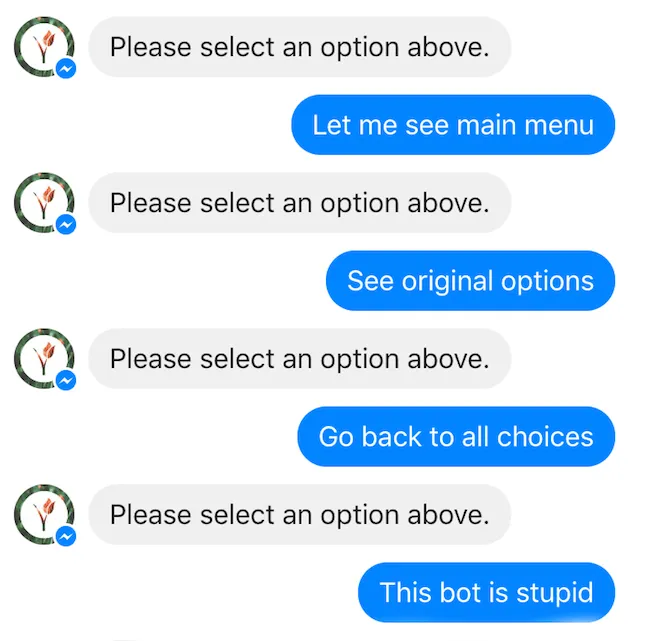Quick wit, unparalleled intellect, and deadpan humour are all the 'good' human-like qualities we associate with AI chatbots, seen only in Hollywood movies and, of course, the Marvel Cinematic Universe.
But, this seemingly smart AI machine, is far from achieving the Pulitzer one day (contrary to what Kris Hammond, Chief Scientist at Narrative Science may say). First things first, if you're not familiar with the concept of a chatbot, let's make it simpler for you.
A chatbot, essentially, is an automated text-based virtual assistant. Think about Google Assistant or Siri. If experience is anything to go by, AI chatbots have been known to be exacting as they are calculating, inaccurate as they are data-driven, and dumb as they are disruptive (in both senses of the word).
Don't believe us? Let's look at the reality that's shaping our future as AI chatbots are making virtual inroads into our daily lives. The following points will put some things into perspective.
AI Chatbots: Super-villain or Superhero 🤔
Most virtually-intelligent machines spin an apocalyptic tale, which may hold some truth to it. And no, we're not talking about the world ending in a dramatic fashion. The 'apocalypse' we're referring to entails the multi-dimensional problems AI chatbots pose today. Let's look at the other half of the coin for a change.
AI Chatbot Challenges:
- Extensive and Expensive Training for Formulaic Tasks
This one's a no-brainer. Truly productive and useful AI-type chatbots require months of training, utmost care, complex resources, and tremendous monetary investment. So, if you're looking to leverage the expertise of an AI chatbot, you may have your work cut out for you. Case in point, Facebook's pilot "Project M" where human intervention was required 70% of the times, a number that's not impressive at all, considering it's the brain-child of a tech-giant.
Another point worth mentioning is how the wrong dataset can negatively alter your customer experience. We know that only once the chatbot is deployed that it can be used to test the waters. So, if the wrong dataset is used to train the bot, then all the effort taken will go down the drain. How so? One, because the bot will have to be retrained, thus requiring more effort and greater investment. Two, the customers would have lost their trust and patience in your product leading to permanent damage to your branding and customer experience. - Inaccurate Content, Incorrect Context
They say you can take a horse to the water, but you can't make it drink, and this saying applies beautifully to AI chatbots as well. Being programmed to respond to 'specific' keywords, they don't have the superpower of 'reading between the lines'.
Plus, despite trillions and trillions of bits of data ingestion and intensive efforts, there are high chances that an AI chatbot will give you a dumb answer (for lack of a better term) in response to your query and will fail to understand the context entirely. Additionally, any attempts at sarcasm or metaphorical references will go in vain, so don't even bother. Naturally, this gives rise to an enraged and frustrating user experience, which can prove to be fatal for any brand. - Limited Applications In Every Sense of the Word
Whether it's the scope, area, or application, an AI chatbot's information bank is limited. This leads to generic responses and unsatisfied users. Some of the major misgivings users face when conversing with a 'stupid' bot include (but are not limited to):
-> Illogical or inappropriate responses.
-> Convoluted answers.
-> Unnatural, artificial, and inauthentic responses.
-> Repetition of responses for different questions.
-> Inability to recognise the user's expectations, wants, and intent. - Mass Appeal or Going Niche (The Chicken-Egg Problem)
Another major concern is the ongoing battle between catering to the masses or embracing a niche audience. Popular AI chatbots like Siri, Alexa, and Google Assistant cater to a general audience. As you may have guessed, this comes with some obvious shortcomings:
One, it's hard to take the 'sophisticated' approach when developing them. If they're not easily understood, they're not really a viable option.
Two, by extension, their 'intelligence' becomes limiting for all the stakeholders involved, especially for the audience at large. This makes sense since these chatbots are developed based on a decision-tree logic where the chatbot's response is triggered depending on fixed keywords from the customers.
Three, going niche would mean a restricted audience and limited appeal which isn't a wise decision, financial or otherwise (at least at this stage of chatbot maturity). All in all, the advent of AI chatbot emerges as a bit of a catch-22 situation, don't you agree? So, what are our options? We have one word for you: UX.


Why UX > AI for Chatbots
Imagine this. Say your brand strategy requires you to
- Humanize your brand and differentiate from your competition
- Converse one-on-one with your customers on a global scale
- Enhance user engagement 3X and widen your target audience
- Create meaningful conversations and result-driven outcomes
- Address customer concerns without any delay
- Deliver a “personalized” experience where the customer feels truly valued
- Undertake feedback-driven tools such as surveys etc.
In such scenarios, you may wonder whether these objectives are truly attainable? We say, yes. By way of an intuitive, conversational chatbot expertly designed with exceptional UX features. A productive UX design that entertains and engages with all your customers all the time. Simply put, at Collect.chat, great UX is not only about creating a “chat window,” it’s also about insightful writing, technical investment, and continuous iterations.
We've embraced the most simplistic and obvious route to create a bot that embodies your brand's traits and feels human. This ethos has driven us to our collective invention, the "Collect.chat bot." Our chatbots can qualify and convert your visitors into customers by engaging them in conversations rather than dull, boring forms. Are you intrigued yet? Here’s a snapshot of our chatbot below

Let's understand how our rule-based chatbots can not only compete with the AI counterparts but outperform them as well.
Our working principle
Our transactional chatbot pre-defines the conversation by considering all possible conversation cases to create a "smart conversation flow."

This translates into meaningful, detailed exchanges that are universal, prompt, personalised, and humanising. Following are the key characteristics of such bots:
- Simplified, Organic, Casual UX
Our team of intuitive designers work towards understanding user behaviour and how each conversation would be scripted, which leads to an enhanced UX. This ultimately contributes to smart and naturalistic chat flows providing answers that are neither dumb nor vague. Caution: On the contrary, they may be fun, seamless, or downright real. - Easy-to-Use
This chatbot can be easily implemented in three quick steps by a professional or a novice. All you have to do is simply follow these steps
-> Use the drag-and-drop style bot-builder to add relevant questions and customise.
-> Install and share the bot using HTML code, a Wordpress plugin, Blog posts, or Links.
-> Get instant notifications via email, Collect.chat dashboard, and Zapier/API callbacks
Voila, you're done! - Conversational, Proactive, and Multi-Purpose Interface
Using this user-friendly technology, you can build email lists, generate leads, schedule appointments, leverage guidance on products/services, collect feedback, and draft surveys among other things. - Integrative and Intuitive Technology
If your bot is created without having the dual ability to integrate with other tools and automate tedious tasks, it is rather pointless. With our Zapier’s “Catch Hook” integration, you can connect Collect.chat with hundreds of apps in your workflow like Salesforce, Freshdesk, Google sheets, Slack - that too, without any complex coding! The process is straight forward. Collect.chat collects responses from the visitor and triggers an event into Zapier via webhooks. From there, Zapier pushes the data to the app of your choice. A win-win for all. - Customise Away
You can use Collect.chat in different ways and forms. It all depends on your current needs. Some examples include using it as a widget, embedding it in your website's content, using it to make interactive blogs, or making conversational landing pages.
(A honest confession: In instances where the bot fails to handle the task/concern at hand, it simply redirects the enquiry to a human via email or chat. One way or another, our escalation workflow mechanism in place ensures that the issue is addressed as promptly and as humanly, or in this case as virtually as possible.)
AI or Transactional Chatbots: A Reality Check
We aren't particularly an anti-AI chatbot lot. We are aware that AI chatbots come with a sense of novelty and have emerged as a Herculean task for innovators and developers alike, confirmed by the fact that in the case of chatbots, words do all the talking and working. It is this central idea that encouraged us onto the path 'less-travelled' of birthing a 'bot brain' that actually works. Taking a bite of the reality sandwich, we have arrived at our journey with pretty-much three-fold objectives:
- To innovate rule-based chatbots that double up as conversational digital personalities, ones that answer user questions with 'smart' answers, every single time.
- To bridge the ever-widening gap between the audience' expectations and the chatbot’s capabilities by way of intuitive and personalised chat flows.
- To link customer intent with bot action and everything in between with real conversations.
With all that said, it's up to you to decide what type of bot you should create for your use-case. Always, the best place to start is with transactional bots since they allow you to go into deployment and test the waters very quickly. Getting active feedback from your users is the best way to improve your bot. Within a week or month, you should be able to understand if you need an AI solution or will a transactional bot solve your problems. If you are wondering where to start with transactional bots, please watch this Quick Start video right here







